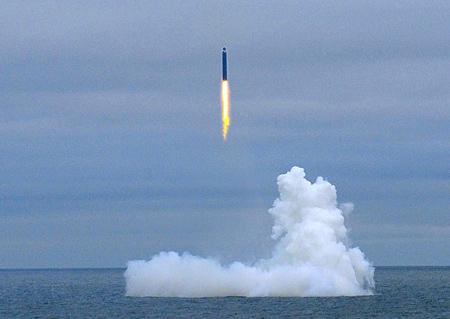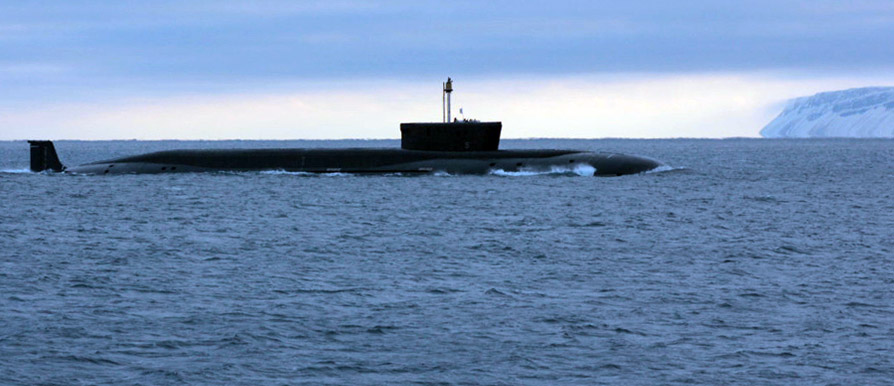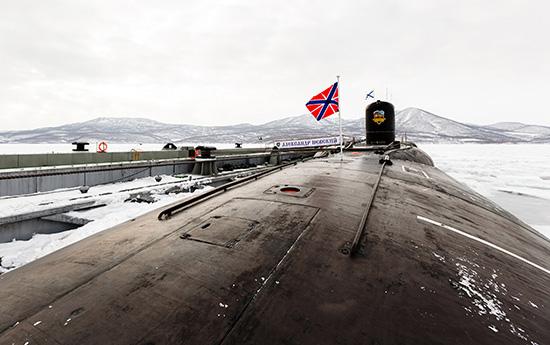The VPMakeyev State Rocket Center Academician has received a government contract for the design and development of a new ballistic missile. Nothing strange except that for the first time, reference is made to the missile substitute Bulava, not yet entered service, but plagued by numerous development problems. According to the newspaper's statement Izvestia, the new missiles will equip both the fourth-generation ballistic class submarines Borei than those of fifth grade Husky.
Let's go with order. The fourth-generation class submarines Borei will involve the backbone of the strategic nuclear deterrent of the Russian Navy. They will replace the class submarines Typhoon, DeltaE-3 Delta-4. The first Borei, Project 955, I am the K-535 Yury Dolgoruky who joined the Northern Fleet in January of the 2013, followed by the K-550 Aleksandr Nevskij (opening photo) at the end of December of the same year. The Nevsky is in service with the Pacific Fleet. The K-551Vladimir Monomakh (following photos) entered service in the 2014. Fourth Borei, the Knyaz Vladimir, Progetto 955 / A, is under construction since July 2012 at the Sevmash shipyard, in northern Russia. The construction of the fifth nuclear-powered submarine the Knyaz Oleg began in July of the 2014. Work on Generalissimus Suvorov they started in December last year. A few weeks later, even the seventh Borei, baptized Imperator Aleksandr III, entered production at the Severodvinsk construction site. The last of the class Knyaz Pozharsky, should be launched by next December. Despite the rumors, there are no confirmations on two other possible submarines.
Within the 2020, the Russian Navy plans to operate on a total of eight class ballistic submarines Borei: three 955 and five 955-A. Considering the structural changes, it would not be a mistake to define the 955-A submarines as a class Borei-II. Designed on a hydrodynamic hull designed to reduce broadband noise emissions, the class Borei it is the first in the Russian navy to use propulsion pump-jet.
 Submarines Borei they are long 170 meters, with a diameter of 13 meters and a maximum immersion speed of 46 kilometers per hour conferred by the OK-650 nuclear reactor. The operational depth is attested on the 380 meters (maximum test occurred at 450 meters). Every Borei should carry sixteen to twenty missiles Bulava (only for 955A), each of which has from six to ten Mirv titles.
Submarines Borei they are long 170 meters, with a diameter of 13 meters and a maximum immersion speed of 46 kilometers per hour conferred by the OK-650 nuclear reactor. The operational depth is attested on the 380 meters (maximum test occurred at 450 meters). Every Borei should carry sixteen to twenty missiles Bulava (only for 955A), each of which has from six to ten Mirv titles.
The three-stage missile Bulava, codename Nato SS-N-30 Mace, is the naval version of the most advanced Russian ballistic missile, the SS-27 Topol-M. It can also be launched in motion. It carries up to 10 Mirv warheads, can hit targets up to eight thousand kilometers away and is designed to exclusively equip class nuclear submarines Borei (changes on Typhoon were deemed too expensive). Despite numerous failures due to manufacturing defects, the Russian army has always maintained that there was no alternative to the Bulava. Due to the failure during the tests of the new intercontinental missiles Bulava, the Borei they are not yet able to carry out their primary task, namely nuclear deterrence.
Each Bulava missile (along 12,1 meters, 2,1 meter diameter and heavy 36,8 tons) is armed with 6-10 thermonuclear warheads for 96-196 submarine tested. The possible coverage of sensitive targets, considering the range of eight thousand kilometers, could be the Barents Sea and the Sea of Okhotsk. If the Russians launched from these areas, they could hit any point in the continental United States. The first Borei, the "Yury Dolgoruky" K535, cost the Russian government slightly less than 720 million dollars, including research and development chapters. Within the next three months, the Russians should carry out a multiple launch of intercontinental ballistic missiles. The tests are part of the (additional) maneuvers planned by the Russian Admiralty for the entry into service of the strategic deterrent weapon system. It is confirmed that to launch the missiles Bulava will be the class submarines Borei Yuri Dolgoruky e Vladimir Monomakh and Dmitry Donskoy class Typhoon. Multiple launches will have to demonstrate the reliability of submarines, which will have to be able to fire on the move, at a depth of 50 meters and with rough seas. The test launches will end within the year. The missiles will be launched from the submarines of the Northern and Pacific Fleet. It will be the last nuclear-powered missile class submarine Typhoon (according to the NATO classification), the Dmitry Donskoy, to launch the latest salvo of Bulava.
 THEAkula (according to the correct Russian identification) he made 14 launches between the 2003 and the 2010 in "double sub" mode, half of which were aborted. In the State Rocket Center statements, the fifth-generation class submarines are also mentioned Husky which should enter service by the middle of the 2035. Although they are still on paper, of the class Husky exceptional performances are told. Although the class specifications Husky are covered by military secrecy, we know that they will support the class attack submarines Yasen, although they will be built in a greater number than the 885m Project. The Husky will be made in two versions, both based on the same hull. The main difference will be determined by the main weapon system delivered. The Husky-A they will replace the class Akula, Sierra e Victor III. The Husky-B, SSGN variants, will replace the class Antey, 949A project. The SSGN variant could be the first in the world equipped as standard equipment with hypersonic cruise missiles Zircon.
THEAkula (according to the correct Russian identification) he made 14 launches between the 2003 and the 2010 in "double sub" mode, half of which were aborted. In the State Rocket Center statements, the fifth-generation class submarines are also mentioned Husky which should enter service by the middle of the 2035. Although they are still on paper, of the class Husky exceptional performances are told. Although the class specifications Husky are covered by military secrecy, we know that they will support the class attack submarines Yasen, although they will be built in a greater number than the 885m Project. The Husky will be made in two versions, both based on the same hull. The main difference will be determined by the main weapon system delivered. The Husky-A they will replace the class Akula, Sierra e Victor III. The Husky-B, SSGN variants, will replace the class Antey, 949A project. The SSGN variant could be the first in the world equipped as standard equipment with hypersonic cruise missiles Zircon.
the class Husky it will be much smaller, there is talk of a displacement of 6 thousand tons, and less expensive than the class Yasen. According to some rumors, the Husky could implement a certain degree of automation, with some of the systems already tested in the 705 class project Lira.
Moscow may have succeeded in optimizing the technology of the liquid metal reactor (the class Lira used the lead-bismuth to cool the reactors). If so, the designers would be able to overcome the typical criticalities that reveal such a system. Specifically, a liquid metal reactor generates more energy and is much more compact than pressurized water. However, liquid metal requires a constant optimum temperature and external support structures for oxide removal.
- Husky could introduce the massive use of composite materials already tested in the classroom Yasen, in an attempt to drastically reduce their acoustic signatures. Again, we only have rumors. We know that Moscow continues to invest enormous resources in the experimentation of new multi-layer composite materials, able to reduce the acoustic signature, isolate the vibrations or absorb them. The Russians are convinced of being able to use the new composite materials to make every part of the Husky, including hulls. The first test at sea with the new composite material will take place within the 2018.
 (photo: MoD Russian Federation)
(photo: MoD Russian Federation)












